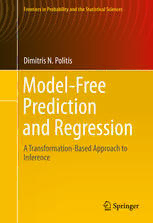Table Of ContentFrontiers in Probability and the Statistical Sciences
Dimitris N. Politis
Model-Free
Prediction
and Regression
A Transformation-Based Approach to
Inference
Frontiers in Probability and the Statistical Sciences
Editor-inChief:
SomnathDatta
DepartmentofBioinformatics&Biostatistics
UniversityofLouisville
Louisville,Kentucky,USA
SeriesEditors:
FrederiG.Viens
DepartmentofMathematics&DepartmentofStatistics
PurdueUniversity
WestLafayette,Indiana,USA
DimitrisN.Politis
DepartmentofMathematics
UniversityofCalifornia,SanDiego
LaJolla,California,USA
HannuOja
DepartmentofMathematicsandStatistics
UniversityofTurku
Turku,Finland
MichaelDaniels
SectionofIntegrativeBiology
DivisionofStatistics&ScientificComputation
UniversityofTexas
Austin,Texas,USA
Moreinformationaboutthisseriesathttp://www.springer.com/series/11957
Dimitris N. Politis
Model-Free Prediction
and Regression
A Transformation-Based Approach
to Inference
123
DimitrisN.Politis
DepartmentofMathematics
UniversityofCalifornia,SanDiego
LaJolla,CA,USA
FrontiersinProbabilityandtheStatisticalSciences
ISBN978-3-319-21346-0 ISBN978-3-319-21347-7 (eBook)
DOI10.1007/978-3-319-21347-7
LibraryofCongressControlNumber:2015948372
SpringerChamHeidelbergNewYorkDordrechtLondon
©TheAuthor2015
Thisworkissubjecttocopyright.AllrightsarereservedbythePublisher,whetherthewholeorpartof
thematerialisconcerned,specificallytherightsoftranslation,reprinting,reuseofillustrations,recitation,
broadcasting,reproductiononmicrofilmsorinanyotherphysicalway,andtransmissionorinformation
storageandretrieval,electronicadaptation,computersoftware,orbysimilarordissimilarmethodology
nowknownorhereafterdeveloped.
Theuseofgeneraldescriptivenames,registerednames,trademarks,servicemarks,etc.inthispublication
doesnotimply,evenintheabsenceofaspecificstatement,thatsuchnamesareexemptfromtherelevant
protectivelawsandregulationsandthereforefreeforgeneraluse.
Thepublisher,theauthorsandtheeditorsaresafetoassumethattheadviceandinformationinthisbook
arebelievedtobetrueandaccurateatthedateofpublication.Neitherthepublishernortheauthorsor
theeditorsgiveawarranty,expressorimplied,withrespecttothematerialcontainedhereinorforany
errorsoromissionsthatmayhavebeenmade.
Printedonacid-freepaper
SpringerInternational PublishingAGSwitzerlandispartofSpringerScience+Business Media(www.
springer.com)
Fu¨rdiezwei ViolinenunddieViolades
Model-FreienQuartetts
Preface
Predictionhasbeenoneoftheearliestformsofstatisticalinference.Theemphasis
onparametricestimationandtestingseemsto onlyhaveoccurredabout100years
ago;seeGeisser(1993)forahistoricaloverview.Indeed,parametricmodelsserved
as a cornerstone for the foundation of Statistical Science in the beginning of the
twentiethcenturybyR.A.Fisher,K.Pearson,J.Neyman,E.S.Pearson,W.S.Gosset
(alsoknownas“Student”),etc.;theirseminaldevelopmentsresultedintoacomplete
theoryofstatisticsthatcouldbepracticallyimplementedusingthetechnologyofthe
time,i.e.,penandpaper(andslide-rule!).
While some models are inescapable, e.g., modeling a polling dataset as a se-
quence of independentBernoullirandom variables, others appear contrived,often
invoked for the sole reason to make the mathematics work. As a prime example,
theubiquitous—andtypicallyunjustified—assumptionofGaussiandatapermeates
statisticstextbookstotheday.Modelcriticismanddiagnosticsweredevelopedasa
practicalwayout;seeBox(1976)foranaccountofthemodel-buildingprocessby
oneofthepioneersofappliedstatistics.
With the advent of widely accessible powerful computing in the late 1970s,
computer-intensivemethodssuchasresamplingandcross-validationcreatedarev-
olutioninmodernstatistics. Usingcomputers,statisticiansbecameabletoanalyze
big datasets for the first time, paving the way towards the “big data” era of the
twenty-first century. But perhaps more importantwas the realization that the way
wedotheanalysiscould/shouldbechangedaswell,aspractitionersweregradually
freedfromthe limitationsofparametricmodels.Forinstance,thegreatsuccessof
Efron’s(1979)bootstrapwasinprovidingacompletetheoryforstatisticalinference
underanonparametricsettingmuchlikeMaximumLikelihoodEstimationhaddone
halfacenturyearlierundertherestrictiveparametricsetup.
Nevertheless,thereisafurtherstep onemaytake,i.e.,goingbeyondevennon-
parametricmodels,andthisisthesubjectofthemonographathand.Toexplainthis,
letusmomentarilyfocusonregression,i.e.,datathatarepairs:(Y ,X ),(Y ,X ),...,
1 1 2 2
(Y ,X ),whereY isthemeasuredresponseassociatedwitharegressorvalueofX.
n n i i
Thereareseveralwaystomodelsuchadataset;threemainonesarelistedbelow.
vii
viii Preface
Theyallpertaintothestandard,homoscedasticadditivemodel:
Y =μ(X)+ε (1)
i i i
wheretherandomvariablesεareassumedtobeindependent,identicallydistributed
i
(i.i.d.)fromadistributionF(·)withmeanzero.
• Parametricmodel: Both μ(·)andF(·)belongtoparametricfamiliesoffunc-
tions,e.g.,μ(x)=β +βxandF(·)isN(0,σ2).
0 1
• Semiparametricmodel: μ(·)belongstoaparametricfamily,whereasF(·)does
not;instead,itmaybeassumedthatF(·)belongstoasmoothnessclass,etc.
• Nonparametric model: Neither μ(·) nor F(·) can be assumed to belong to
parametricfamiliesoffunctions.
Despite the nonparametric aspect of it, even the last option constitutes a model,
and is thus rather restrictive. To see why, note that Eq.(1) with i.i.d. errors is not
satisfied inmanycases ofinterestevenafterallowingforheteroscedasticityofthe
errors. For example, consider the modelY =G(X,ε), where the ε are i.i.d., and
i i i i
G(·,·)isanonlinear/non-additivefunctionoftwovariables.Itisforthisreason,i.e.,
to render the data amenable to an additive model such as (1), that a multitude of
transformationsin regressionhavebeen proposedand studiedoverthe years,e.g.,
Box-Cox,ACE,AVAS,etc.;seeLintonetal.(1997)forareview.
Nevertheless,itispossibletoshunEq.(1)altogetherandstillconductinference
aboutaquantityofinterestsuchastheconditionalexpectationfunctionE(Y|X=x).
Incontrasttononparametricmodel(1),thefollowingmodel-freeassumptioncanbe
made:
• Model-freeregression:
– Randomdesign.Thepairs(Y ,X ),(Y ,X ),...,(Y ,X )arei.i.d.
1 1 2 2 n n
– Deterministicdesign.ThevariablesX ,...,X aredeterministic,andtheran-
1 n
dom variablesY ,...,Y are independentwith common conditionaldistribu-
1 n
tion,i.e.,P{Y ≤y|X =x}=D (y)notdependingon j.
j j x
Inferenceforfeatures,i.e.,functionals,ofthecommonconditionaldistributionD (·)
x
is still possible under some regularity conditions, e.g., smoothness. Arguably,the
mostimportantsuchfeatureistheconditionalmeanE(Y|X=x)thatcanbedenoted
μ(x).Whileμ(x)iscrucialinthemodel(1)asthefunctionexplainingY onthebasis
ofX =x,ithasakeyfunctioninmodel-freepredictionaswell: μ(x )isthemean
f
squared error (MSE) optimal predictor of a future response Y associated with a
f
regressorvaluex .
f
Aswillbeshowninthesequel,itispossibletoaccomplishthegoalofpointand
intervalpredictionofY undertheabovemodel-freesetup;thisisachievedviathe
f
Model-freePredictionPrincipledescribedin PartI of thebook.In so doing,the
solutiontointerestingestimationproblemsisobtainedasaby-product,e.g.,infer-
ence on features of D (·); the prime example again is μ(x). Hence, a Model-free
x
approach to frequentist statistical inference is possible, including prediction and
confidenceintervals.
Preface ix
Innonparametricstatistics,itiscommontotrytodevelopsomeasymptoticthe-
oryfornewmethodsdeveloped.Inadditiontoofferingjustificationfortheaccuracy
of these methods,asymptoticsoftenprovideinsightson practicalimplementation,
e.g., on the optimal choice of smoothing bandwidth, etc. All of the methods dis-
cussed/employedin the proposed Model-free approach to inference will be based
on estimators that have favorable large-sampleproperties—such as consistency—
under regularity conditions. Furthermore, asymptotic information on bandwidth
rates,MSE decayrates, etc.will begivenwheneveravailablein the formof Facts
orClaimstogetherwithsuggestionsontheirproofand/orreferences.However,for-
maltheoremsandproofsweredeemedbeyondthescopeofthismonographinorder
tobetterfocusonthemethodology,aswellaskeepthebook’slength(andtimeof
completion)undercontrol.Perhapsmoreimportantly,notethatitisstillunclearhow
toproperlyjudgethequalityofpredictionintervalsinanasymptoticsetting;some
preliminaryideasonthisissuearegiveninSects.3.6.2and7.2.3,andtheRejoinder
ofPolitis(2013).
Interestingly,theemphasisonpredictionseemstobecomingbackfull-circlein
thetwenty-firstcenturywiththerecentboominmachinelearninganddatamining;
see, e.g., the highlyinfluentialbookonstatistical learningby Hastie etal. (2009),
and the recent monograph on predictive modeling by Kuhn and Johnson (2013).
TheModel-freepredictionmethodspresentedhereareofaverydifferentnaturebut
share some similarities, e.g., in employing cross-validation and sample re-use for
fine-tuning and optimization, and may thus complement well the popular model-
basedapproachestopredictionandclassification.Furthermore,ideasfromstatisti-
callearningandmodelselectioncouldeventuallybeincorporatedintheModel-free
frameworkas well, e.g., selecting a subset of regressors;this is the subjectof on-
goingwork.Notably,themethodspresentedinthismonographareverycomputer-
intensive; relevant R functions and software are given at: http://www.math.
ucsd.edu/˜politis/DPsoftware.html.
I would like to thank my colleagues in the Departments of Mathematics and
Economics of UCSD for their support, and my Ph.D. students for bearing with
someofthematerial.Ihavebenefitedimmenselyfromsuggestionsanddiscussions
withcolleaguesfromallovertheworld;averypartiallistincludes:IanAbramson,
EryArias-Castro,BrendanBeare,PatriceBertail,RicardoCao,AnirbanDasGupta,
RichardDavis,BradEfron,PeterHall,XumingHe,NancyHeckman,Go¨ranKauer-
mann,ClaudiaKlu¨ppelberg,PiotrKokoszka,Jens-PeterKreiss,MicheleLaRocca,
Jacek Leskow, Tim McMurry, George Michailidis, Stathis Paparoditis, Mohsen
Pourahmadi, Jeff Racine, Joe Romano, Dimitrios Thomakos, Florin Vaida, Slava
Vasiliev,PhilippeVieu,andMichaelWolf.Furtheracknowledgementsaregivenat
theendofseveralchapters.
In closing, I would like to thank the Division of Mathematical Sciences of the
NationalScienceFoundationfortheircontinuingsupportwithmultiplegrants,the
most recent ones being DMS-10-07513and DMS 13-08319,and the John Simon
GuggenheimMemorialFoundationfora2011–2012fellowshipthathelpedmeget
started on this monograph. I would also like to thank Marc Strauss and Hannah

